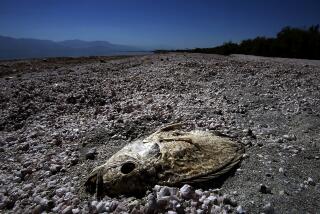Biologists Have Plan to Help Lake Mead Sport Fishing
In an effort to reverse Lake Mead’s declining sport fishery, biologists may attempt to fertilize the 30-by-50-mile lake next summer with about 40 tons of ammonium phosphate.
Mead, as recently as the 1960s, was considered one of America’s best largemouth bass fisheries. Since the ‘70s, however, there has been a steady decline of catches of largemouth and striped bass, as well as rainbow trout.
According to a team of limnologists at the University of Nevada Las Vegas, the decline has been caused largely by strict federal clean-water regulations in effect at the Clark County Advanced Wastewater Treatment plant in Las Vegas. Limnology is the study of physical, biological and chemical properties of fresh water.
Dr. Larry Paulson, who heads the Lake Mead Limnological Research Center at UNLV, wants to have the 40 tons of ammonium phosphates added to 40,000 acres of Mead in Overton Arm and Gregg Basin to make up for the phosphorous lost because of the clean-water regulations.
Phosphates are the first building blocks in a freshwater lake’s food chain. They produce algae, which produce plankton, which produce shad, which are eaten by the lake’s prime game fish--striped and largemouth bass and rainbow trout. Since 1977, the average weight of caught striped bass has declined from 5.95 pounds to 1.79 pounds.
“Mead’s sport fish troubles really started in 1963, when Glen Canyon Dam was completed upstream,” Paulson said. “At that point, the dam blocked the flow of phosphorous into Mead.”
Said Arizona Game and Fish Department fisheries biologist Tom Liles: “Trying to grow fish in water without phosphorous is like trying to grow cows on a beach.”
Mead wasn’t entirely cut off from a source of phosphorous, however. Abundant quantities of phosphorous once flowed into the lake in Las Vegas Wash. Then stiffer Environmental Protection Agency regulations for sewage water reduced the phosphorous content of water coming out of the Clark County Advanced Wastewater Treatment Plant.
The issue is a sensitive one to such Nevada communities as Henderson and Boulder City near Mead, since more than a half-million fishermen visit Mead each year. However, presumably due to lower catch rates, angler numbers declined from 716,000 in 1983 to 588,000 in 1984.
Muts Hirose of Orange wonders why the penalties for poaching abalone haven’t gone up since 1937. He points out that someone was recently fined $25 plus $5 for each illegally taken abalone. He says he remembers a case in 1937 when the penalty was exactly the same.
He writes: “The price of abalone has increased at least 60 times since 1945. . . . Shouldn’t the fines be readjusted accordingly? If not, at least, $500 plus $100 per illegal abalone.”
John Guth, owner-operator of Martinez Lake Resort on the Lower Colorado River, reports three years of high-water levels in Martinez Lake--30 miles north of Yuma, Ariz.--has resulted in ideal largemouth bass spawning habitat.
Many croaker and tilapia die each year when the Salton Sea “turns over,” or experiences its “red” or “green tide” condition. Nevertheless, local health officials had tissue samples of the fish sent to state labs for testing for heavy metals, DDT and PCB.
Normal fish die-offs occur when heavy winds stir up decaying organic matter on the shallow sea floor. As the matter moves into the water column, it depletes oxygen and kills schooling fish. As more fish die, they decay and consume even more oxygen.
Briefly The Balboa Angling Club will hold a saltwater fly fishing school March 29-31, with experts Nick Curcione, Mark Sosin and Lefty Kreh scheduled to instruct. . . . John Turner of Martinez, Calif., recently made the winning bid for a Nevada desert bighorn sheep hunting tag--$42,000--at the North American Wild Sheep convention in Reno. . . . Department of Fish and Game officials are hoping to net at least $480,000 from this year’s state income tax checkoffs to aid threatened and endangered state wildlife. . . . The Fish and Game Commission will adopt 1985-86 mammal and furbearer hunting regulations at its Sacramento meeting next Friday. . . . Tournament time: Balboa Angling Club Master Angler Billfish tournament, Sept. 13-14; Lucky Trojans Billfish tournament, June 16-22, Hotel Spa, Rancho Buena Vista, Mexico. . . . Budweiser Shooting & Hunting Sports Fair, May 17-19, Raahauge’s Pheasant Hunting Club, Norco.
More to Read
Sign up for Essential California
The most important California stories and recommendations in your inbox every morning.
You may occasionally receive promotional content from the Los Angeles Times.










